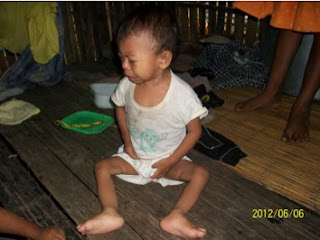“Lots of people died. Children! Fourteen years and below,” he said. “They took them to Lima and they died there. The doctors came and said ‘It’s not gas, it’s not gas, it’s the bat-illness that bit them.’ I said, ‘What if you’re lying?’”
 |
| Young girl from the community of Camana who died, presumably of rabies, in May 2012. Photo taken by a community member and used with permission. |
“In 2012 the pipeline broke. They said it didn’t break, but it just leaked a little. In the month of March, at the beginning. They said ‘Don’t worry, the water is safe, the contamination isn’t coming downstream.’ But then it started raining and the floods bought all that contamination down here close to the community.
“Ohohoh!," he shook his head and then continued in the staccato cadences of the Matsigenka language, “It messed up the river… At first I didn’t notice it, I was eating armored catfish and they had a strange smell. And then I thought, ‘It has come down here after all. People are going to get sick. We might die.’ And then my wife got sick. And the doctors came and said it was rabies. The bat-illness that bit her. I said ‘No way! It was gas!’ Has a bat bitten my wife? She was never bitten by a bat. I built my house carefully. You don’t get rabies so easily.”
A 600 km pipeline carries natural gas from the Camisea gas fields—among the largest natural gas deposits in all of South America—from the Urubamba region in the upper Amazon, across the Andes to refineries near Paracas Marine Reserve on the Peruvian coast. The pipeline supplies over 40% of Peru's natural gas, representing a contribution to the Peruvian economy of about 28% of GDP.[1] The Camisea gas fields are located in the heart of the territory of the Matsigenka, an indigenous Amazonian people of about 12,000 who live in the lower Urubamba, Manu and upper Madre de Dios rivers; some Matsigenka in the Camisea region maintain little or no contact with the outside world. And yet because of Peru's subsoil mineral laws, the Matsigenka people have no direct ownership stake in the gas deposits, which are leased by the government to private companies.
In March 12, 2012, the pipeline administered by Transportadora de Gas del Perú (TGP) near the Matsigenka Native Community of Camana on the Rio Picha (an affluent of the Lower Urubamba) leaked into a small stream known locally as Tsirompia. According to the people of Camana, not only did fish die and become contaminated with a strange odor, but also large animals such as tapir and peccaries that drank contaminated water also died and were found lying in the forest or along the river.
Water samples collected on March 13 by a team sent by the Cusco Health Directorate showed unsafe levels of petrochemicals at two of eight collection points, namely, the points closest to the site where the leak was detected. Unsafe levels continued at these two points through March 18, and a final collection on March 22 showed a return to safe levels at one of these points, although no data is given for the second point.1 The health team concluded that, by the date of its return on March 23, the water in the region was now safe.
Yet a number of people fell ill beginning late March through mid-April, and by May 10 five children had died. According to media reports at the time, the people of Camana blamed these illnesses and deaths on contamination from the gas leak.
A health team sent by the Cusco Health Directorate in May concluded that the deaths did not result from water contamination but rather were probably due to rabies transmitted by vampire bats.[2] In all, eight suspected cases of rabies were documented of which seven (all children or adolescents 14 years old or less) proved fatal. The only survivor was an adult woman, the wife of the man interviewed above. One of the fatal cases was confirmed as rabies by autopsy, and two additional cases showed indications of rabies by indirect laboratory results. The exact cause of the initial five deaths could not be confirmed due to lack of blood or tissue samples, however the report classified them as “probable” rabies cases.
However during my visit to the community in April of 2014 as part of an independent evaluation of social, economic and environmental impacts of gas development in southern Peru, many community members suspected that some or perhaps all of these illnesses and deaths were not a result of rabies, but rather consequences of the gas leak in March.
 |
| “We stopped eating fish for months. There were even cases of children who became malnourished because their parents were afraid to feed them fish.” |
As one man said, “There has not been one case of rabies for years and years. There’s a gas spill, and suddenly people start dying. It’s not rabies: it’s the gas. It’s been another two years since then and not a single case of rabies: it was the gas!”











